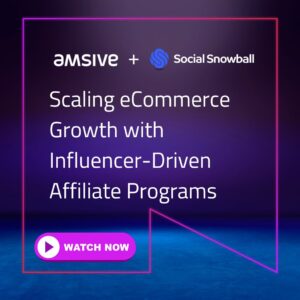Today’s consumers make purchase decisions based on factors beyond a product’s price and functionalities. They’re more likely to buy from brands that are familiar to them and resonate with them. That’s why more companies turn to brand advertising to establish a cohesive and memorable brand presence across channels to drive engagement and conversions.
Companies that invest in brand-building initiatives are seeing results. For example, Microsoft experiences a 100% to 300% conversion lift because of upper funnel brand advertising.
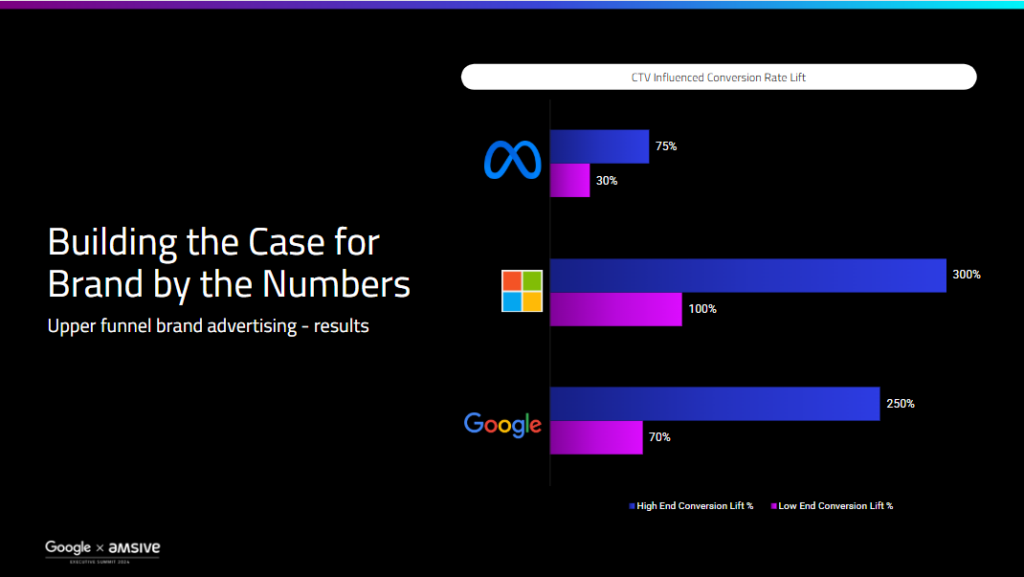
However, various marketing strategy misconceptions prevent companies from investing in brand advertising and using it strategically to drive growth and performance. Let’s examine four brand advertising myths and how you can overcome them.
Myth 1: Brand advertising doesn’t impact performance
Many companies overlook the impact of brand advertising on marketing performance because they only focus on a campaign’s effect on immediate sales instead of long-term brand equity. However, real-world examples show that combining brand equity metrics with performance KPIs helps companies drive sustainable growth in today’s competitive landscape.

Brand advertising creates a strong brand presence, positively influencing the consumer journey from awareness to loyalty. Companies that leverage consistent brand advertising to build brand equity increase their valuation by an average of 11% annually.
Moreover, brand advertising builds trust with consumers in today’s market, where 71% of people say it’s more important to trust the brands they buy today than in the past. When consumers trust a brand, they’re 59% more likely to purchase its products and 67% more likely to become loyal consumers and advocates.
So, how can you demonstrate the importance of brand campaigns in your marketing strategy?
Use short-term and long-term brand performance metrics to understand a campaign’s impact, especially on how it contributes to sustained growth, even if its short-term impacts are not apparent. These KPIs can help you highlight the long-term benefits of brand advertising:
Brand equity metrics, such as brand awareness and brand sentiment.
Consumer engagement metrics like share-of-voice (SOV), social media engagement, and content performance.
Purchase behavior metrics, including CLV, repeat purchase rate, and sales lift analysis.
Financial and business metrics on market share growth, cost per acquisition (CPA), and revenue attribution.
Consumer perception metrics like Net Promoter Score (NPS) and ad recall.
Longevity and consistency metrics, including consumer retention rates and partnership opportunities.
Myth 2: There’s no way of knowing when to spend on brand advertising
The misconception that brand advertising doesn’t affect the bottom line causes companies to miss opportunities to drive impact. But how do you know it’s time to increase your brand advertising spend? There are a few telltale signs, such as decreasing market share, low or declining brand search, declining or low brand awareness, consumer retention, and consumer loyalty. Here are some ways to track these telltale signs.
Fortunately, advanced tools and technologies can help brands identify these signs and time their ad spend strategically based on market conditions and consumer behaviors.
Conduct brand awareness surveys and use SOV tools to compare brand perception against competitors, monitor brand preferences and identify opportunities to fill gaps. Brand health surveys can be set up to establish brand awareness, brand familiarity, purchase intent and more and track against competitors. With this set up, you can start to see how pulling back on brand advertising affects these metrics. If your awareness is lower, your lower funnel efforts will suffer.
Market research platforms provide insights into industry trends and consumer behaviors. You may use Google Trends to monitor search interest for your brand and social listening tools to detect emerging conversations or trends that align with your message.
CRM platforms track consumer buying cycles and behavior patterns, and AI analytics software helps predict consumer trends based on historical data.
You also need to respond promptly to seasonal shifts and cultural moments to align your brand campaigns with consumer sentiment. You may allocate a portion of your brand spend for capturing these real-time opportunities. But remember that not every trend or meme is going to be an authentic pick for your brand. Pick and choose how and when you engage with cultural moments.
Additionally, data-driven decision-making will become increasingly critical in scheduling brand advertising campaigns as consumers expect timely and relevant content. Use analytics tools to help determine the best times to run brand campaigns to maximize engagement rates and ROI. You can also use audience insights and dynamic creative optimization platforms to adapt your messaging based on real-time audience interactions.
Myth 3: It’s hard to know what makes a successful brand campaign
The misconception that good brand campaigns are subjective overlooks the foundational elements that contribute to their success. Effective brand advertising has measurable objectives (e.g., brand awareness, engagement and conversions) and uses data-driven insights, blending rational and emotional elements to drive meaningful consumer behaviors.
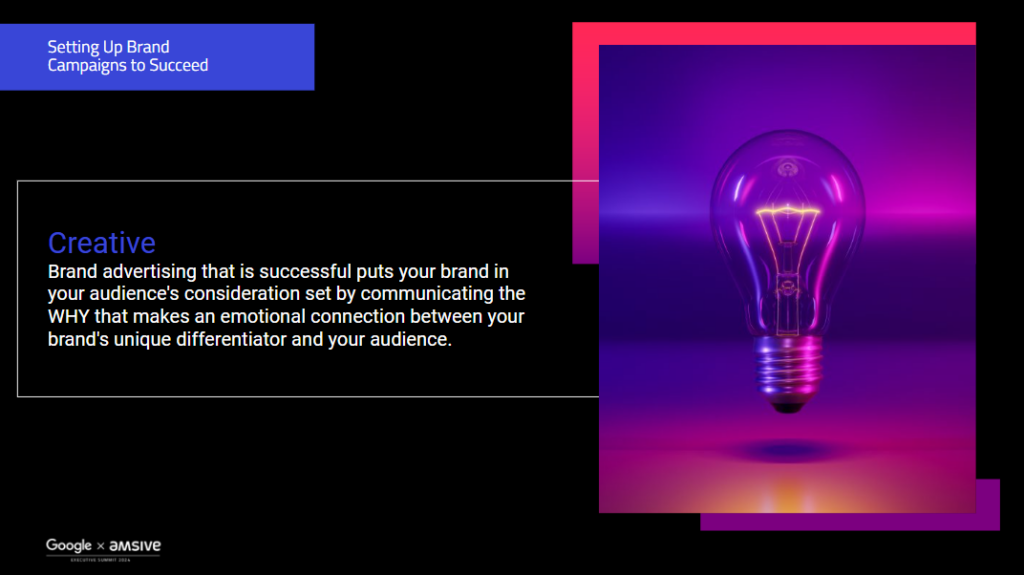
There are three essential brand metrics that are considered hallmarks of successful brand advertising:
Rational brand metrics
These measure brand awareness and familiarity along the funnel. They show consumer trial and usage to help understand conversions, adoption and consumer retention.
Emotional brand metrics
These showcase how prospects that build a mental association such as “is a brand for me”, barriers that impact conversions, what drives attachment and loyalty from existing consumers and brand equity in the marketplace.
Behavioral brand metrics
These measure internal growth (e.g., NPS, consumer loyalty, repeat purchases), external growth and changes in brand valuation.
Effective brand advertising combines powerful creative, relevant messaging and audience targeting to communicate your brand’s “why”—making an emotional connection between the audience and your unique differentiator. It requires a deep understanding of your audience to inform brand campaigns that resonate with them deeply and drive brand loyalty.
Your marketing strategy and brand campaigns must also address shifts in the post-COVID world. What does this mean for advertisers?
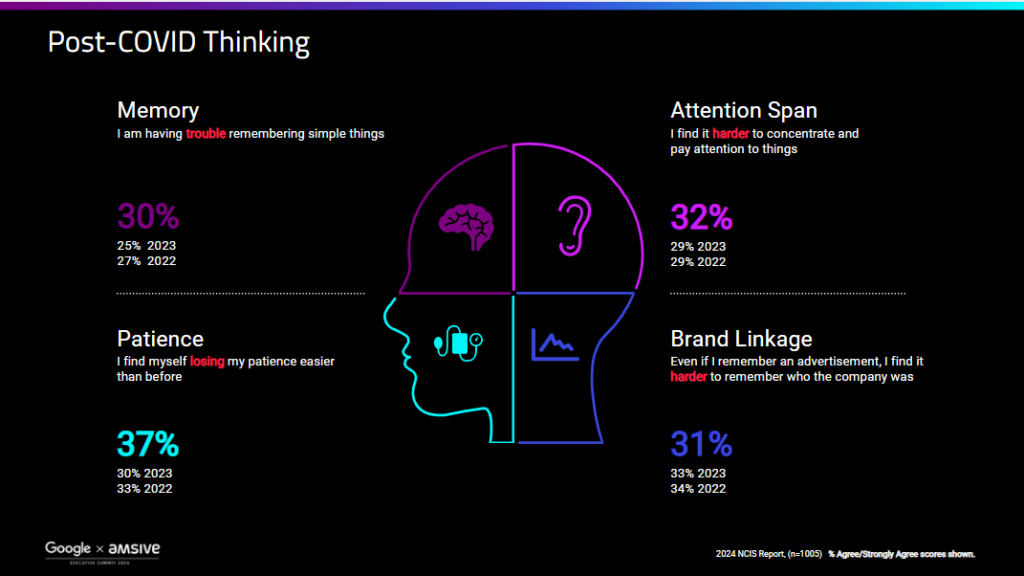
Studies show that since COVID, attention spans are even shorter, memory is less stable and people are finding it harder to link an advertisement to a specific brand.
Your brand campaign should have a strong point-of-view that is simply communicated in a way that is memorable. The key is understanding both the strength of the brand and the motivation of the consumer – where those two intersect is the sweet spot. Doing the upfront brand strategy work using research, data, and valuable insights is the key to driving breakthrough advertising – there are no shortcuts.
Support your strategy with the appropriate ad spend to maximize reach and frequency. When appropriate, leverage always-on brand campaigns that run continuously throughout the year to augment brand presence, build brand awareness and drive consumer loyalty.
Set up your brand campaigns to succeed by establishing the proper expectations. This requires patience because with upper funnel brand advertising, the results will not be apparent overnight. But that doesn’t mean it isn’t working!
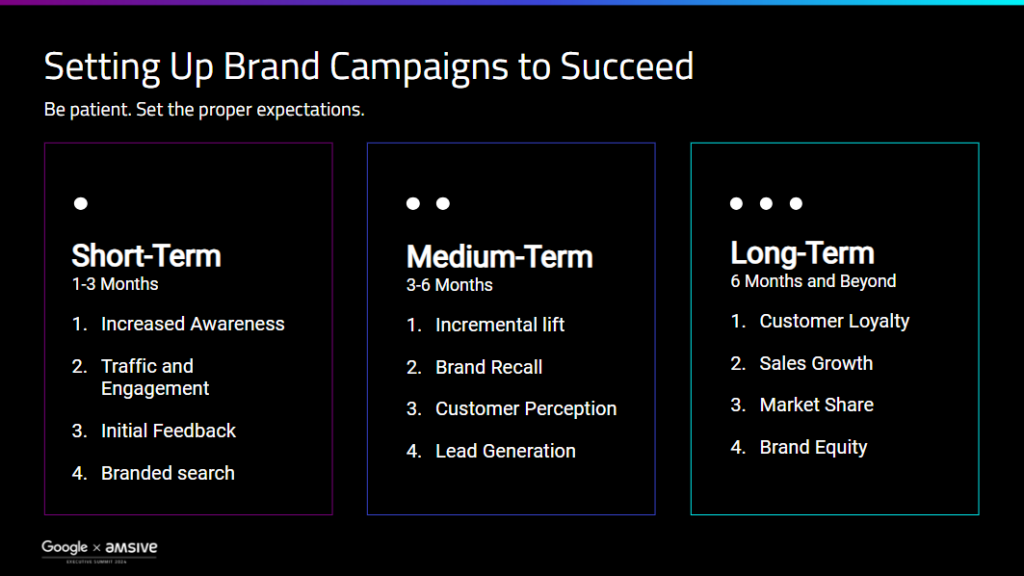
Myth 4: It’s hard to show metrics connecting brand advertising and performance
Many companies shy away from brand campaigns because of the misconception that it’s challenging to align brand advertising with performance outcomes. However, connecting the dots is essential for providing a holistic view of how your campaigns influence long-term brand health and immediate sales performance.
Addressing the gap and aligning metrics also help you better allocate resources between branding and performance-driven efforts while showing how improved brand health drives tangible business impacts. Here are the key metrics that help align brand advertising with performance outcomes:
Consumer lifetime value (CLV)
This is the total revenue a business may expect from a consumer over their relationship with the brand. A strong brand fosters consumer loyalty and increases retention rates, increasing CLV.
You may measure this metric using CRM platforms to analyze purchase patterns and predict future value. You may also combine transactional data with retention rates and average purchase values to calculate CLV.
Brand awareness metrics
These show the extent to which your target audience recognizes and recalls your brand. Improved brand awareness often leads to increased consideration and conversions.
You may measure impression, reach and search volume trends or use survey platforms to measure and track how consumers perceive your brand.
Engagement metrics
Click-through rates (CTR), time spent on your website, social media likes, shares and comments show how consumers interact with your brand’s content and campaigns.
High engagement indicates strong audience interest that correlates with higher conversions and loyalty. You may use social media analytics platforms and website analytics tools to measure engagement.
After identifying the appropriate metrics, you need the right tools and methodologies to track them. Platforms like Google Search Console, SEMrush or Ahrefs help you track shifts in impressions and branded search volume, which indicates changes in brand awareness and interest.
The metrics link branding efforts directly to consumer actions like searching for your brand name or products and reveal trends in consumer intent driven by specific campaigns or promotions.
Meanwhile, recurring online lift studies like Meta Brand Lift, Google Ads Brand Lift, YouTube Brand Lift and YouTube Search Lift measure the impact of brand advertising over time. You may also measure Recurring CTV Influenced Lift and how new creative or strategic changes like different bidding strategies, substantial structural updates or significant audience shifts impact performance. Additionally, you should conduct continuous offline brand studies to predict the impact of budget and creative changes.
These lift studies help quantify the incremental impact of brand campaigns on metrics like awareness, consideration and purchase intent. They establish a direct correlation between exposure to a campaign and subsequent consumer actions (e.g., search and purchase). They also provide actionable insights to help inform targeted improvements and drive measurable outcomes.
Case study: Brand advertising in action
An office supply eCommerce company increased its brand advertising spend to reverse its YoY decline in branded search traffic and increase brand recall. We see an inflection point for an uptick in brand search impressions after a brand push and another one tied to the launch of a similarly named brand.
Then, we experience another surge in impressions after an increase in CTV investment. These upticks in brand search impressions demonstrate the impact of brand advertising in raising brand awareness.
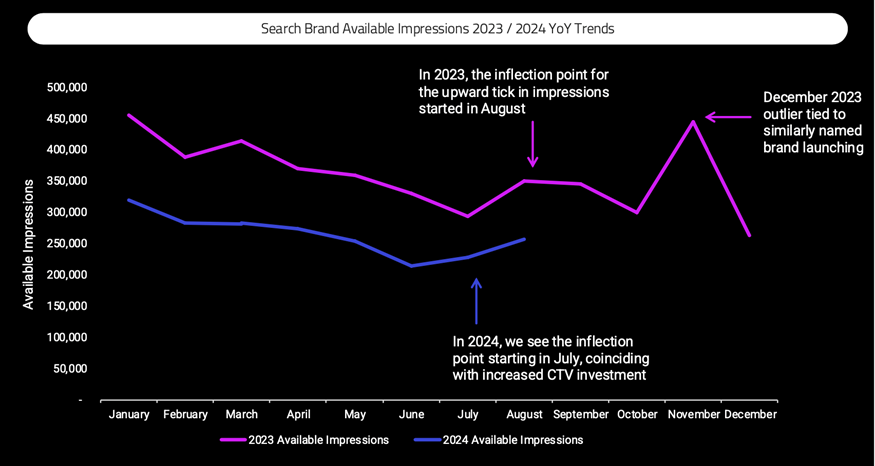
Leverage brand advertising to support marketing strategies
Brand advertising is not a siloed discipline. Instead, it’s closely tied to business performance and should be part of your marketing strategy. To maximize its benefits, you must implement an always-on, multichannel brand advertising strategy to maintain the ground you’ve gained from dedicated campaigns. Moreover, challenger brands must make an even more substantial brand push to differentiate themselves from established players.
Strategic timing for brand campaigns is essential. For example, seasonal shifts and cultural moments may impact consumer perceptions. You must also incorporate elements of successful brand campaigns to address rational and emotional elements that drive consumer behaviors.
Lastly, a data-driven approach is essential for responding to market conditions and consumer sentiment. Marketers must integrate brand metrics with performance data to connect the dots for long-term success.
Ready to drive growth with effective brand advertising? Our brand strategy services can help you put data to work with a plan to reach the right audience, build a loyal base of customers, and drive cross-channel brand cohesion to strengthen brand awareness and recall. Let’s talk to see how we can help you maximize your ad spend.




